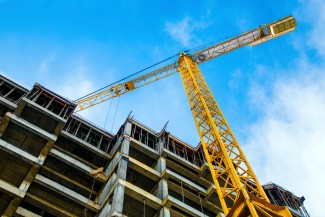A draft model energy code for commercial buildings released Tuesday could reduce net energy use in new buildings by a quarter, which would be a major step toward zero-net-energy and carbon-neutral new buildings. The proposed 2024 International Energy Conservation Code (IECC) is now open for public comment through mid-October, giving stakeholders a brief window to advocate for a strong final version that can be adopted by states and cities around the country.
Residential and commercial buildings are responsible for approximately 40% of U.S. energy consumption. Energy codes are one of the strongest tools for reducing energy use and emissions from new buildings. Strong energy codes are also essential for an equitable energy-efficient economy because they set a minimum standard that all buildings must meet, ensuring that no household or business in a new building is left with needlessly high energy bills.
The proposed 2024 IECC-Commercial model code would require buildings to be significantly more efficient than those adhering to the previous version, from 2021. It would save an estimated 8% to 12% energy from improved energy efficiency, reducing energy costs and greenhouse gas emissions. ACEEE estimates the model code would result in an additional 10% to 12% net energy reduction from new on-site renewable energy requirements (with some exceptions that allow for off-site renewable energy procurement). New provisions that require flexible load management or even more renewable energy could produce an additional 7% energy cost savings. If approved, this would all add up to a major advance in energy codes.
The commercial building provisions of the IECC apply to all commercial buildings and multifamily buildings of four or more stories; an alternative model energy code, ASHRAE 90.1, can also be used to show compliance with the IECC. The IECC becomes effective in states and localities that adopt it, emphasizing the importance of implementation of the most recent version of the model codes. Thirty-two states have adopted some version of the IECC for commercial buildings, six states and D.C. have adopted ASHRAE 90.1 alone, two states (California and Washington) have their own energy code, and ten states have no statewide energy code.
What’s new in the draft code?
ACEEE and other energy efficiency advocates have worked hard to ensure a 2024 IECC that pushes for deep energy and emissions reductions while considering both upfront and energy costs, as well as the ability of jurisdictions to implement the new code. Among the most impactful proposed changes:
- Expanded energy efficiency credits that give building developers the flexibility to select among several measures to meet a prescribed total number of credits required for each building type and climate zone. This framework also has the potential to deliver deeper energy savings over time.
- Mandatory on-site renewable energy, such as from rooftop solar panels. Where on-site installations are limited by physical conditions, exceptions allow for the procurement of off-site renewable energy.
- New requirements to achieve a prescribed number of "Renewable and Load Management Credits" through a combination of additional renewable energy and energy storage. These provisions are aimed at cost savings with the net energy impact dependent on the combination of measures a building developer selects.
- New provisions to cut down on heat loss from thermal bridging (higher-conductivity materials passing through insulation layers) and to further reduce air leakage.
- Reductions in lighting power allowances and new lighting control requirements (e.g., daylight dimming controls in many building areas, occupancy sensors in more spaces).
- Occupancy sensor and control requirements to limit ventilation when certain building spaces are vacant, reducing energy usage for heating or cooling of outside air brought in for ventilation.
- A new computer model-based compliance option that evaluates overall HVAC system efficiency instead of individual component efficiency. This provides flexibility to building developers in complying with the code, as well as an opportunity to significantly improve HVAC system efficiency where individual equipment improvement options may be limited.
A number of other proposals were also approved by the IECC Commercial Consensus Committee responsible for IECC development. The public can comment and suggest modifications to the draft (including entirely new provisions), but any changes would also require a two-thirds majority vote of the committee.
How did we get here?
The IECC is developed on a three-year cycle, and a new process adopted for the current cycle limits the influence of sustainability- and civic-minded state and local officials who have delivered major efficiency gains in recent code cycles. Amid this challenge, ACEEE and other advocates for energy efficiency and emissions reductions have worked to ensure the International Code Council—which runs the IECC development process—delivers on its promise to maximize energy efficiency that is “safe, technologically feasible, and life cycle cost effective.” ACEEE has been a voting member of the IECC Commercial Consensus Committee since the start of the current process in the fall of 2021.
There were some upsides to the new process, as proponents of code change proposals were able to work with committee members and other interested parties to improve their proposals, and working groups were established to address complex or related proposals. But given the time commitment required and the limited influence of those not on the committee, it remains to be seen whether the new process is a sustainable model to reach zero-net-energy and carbon-neutral new construction.
What should we do now?
The work is not done, and the time to have input in this process is now. The International Code Council is accepting public comments on the draft code through October 21. With strong energy efficiency and decarbonization gains in the proposed code, we can expect pushback. Supportive comments in the public review period can help ensure committee members stand firmly on the side of reducing energy costs and fighting climate change. The International Code Council is hosting a webinar on how to submit comments on Friday, September 9 at 11:00 am ET.
ACEEE will continue to work to improve the 2024 IECC during the public review period, advocating that the model code move away from fossil fuel-burning space heating and water heating, ensure all building envelopes meet minimum levels of performance, and increase energy efficiency while avoiding trade-offs with renewables.


